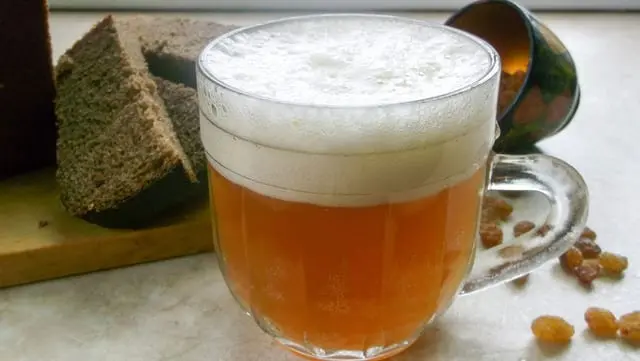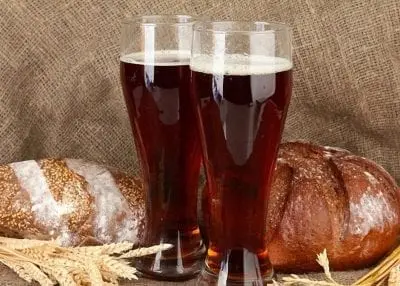Contents
Description
Kvass is a low–alcohol beverage obtained by partial fermentation of dairy or bread yeast. The strength of the drink is only 2.6. Traditionally Slavic peoples made kvass. According to the international classification of kvass, it belongs to beer, but in Russia and Ukraine, it is a standalone drink.
The beverage is old enough. It was known already in Egypt in 3000 BC. Production and consumption of the drink described ancient philosophers Herodotus and Hippocrates. This beverage came about a thousand years ago to the Slavic territory before the Foundation of Kievan Rus. The brew was in high esteem of people of all classes and grades. By the 15th century, there were already more than 500 kinds of kvass. In addition to everyday and widespread use, this drink has been a remedy in hospitals and sick wards for recuperation post-operative patients and improved digestion.
How to make kvass
The brew may be factory or homemade. As a preservative to increase the factory kvass’s shelf life, they also enrich it with carbon dioxide.
In home-prepared kvass, people use bread, fruits, milk, and berries. Berry and fruit varieties are often ordinary kvass, to which they add the juice of pear, Apple, cranberry, cherry, lemon, etc. Sometimes they make such kvass directly from the juice by adding flour or bread.

A classic recipe of kvass includes the following ingredients: yeast, bread crumbs, and sugar. Crackers (200 g), pour boiling water (0.5 l), close lid tightly, and infuse for 2-3 hours. You should filter the ready leaven and add sugar (50 g) and yeast (10 g). Next, leave the brew for 5-6 hours in a warm place. The finished beverage cool and bottle. It is better to consume a drink within two days – otherwise, it will become sour.
Factory kvass they make from either natural products of fermentation of rye or barley malt, or synthetic mixtures consisting of kvass flavorings, sweeteners, colorants, often burnt sugar, water, and carbon dioxide. They poured the finished beverage into kvass trucks for street sale or in plastic bottles of 0.5-2 liters. These drinks are not always of good quality and do not have such useful properties as natural home-made kvass.

Kvass benefits
The content in the kvass of lactic acid and acetic acid helps quench thirst, aid digestion, improve metabolism. It also has a calming effect on the nervous system. Contained in the brew, the enzymes reduce the number of pathogenic organisms in the stomach and bowels. They raise the tone of muscles, relieve fatigue, strengthen blood vessels and heart muscle. The brew contains in its composition vitamins, amino acids, and trace elements, which positively affect the body when beriberi, scurvy, brittle teeth, and damaged tooth enamel.
Kvass acids have an immunomodulating function, have an effective therapeutic effect on hypertension and goiter. The brew effects on the organism are comparable with products such as kefir, yogurt, and kumis.
Kvass B vitamins support the health of the hair, strengthen the follicles and give a natural Shine. In turn, vitamins PP and E heal the skin and the complexion, smooth wrinkles. Kvass also has antibacterial properties. Its environment killed the causative agents of typhoid, cholera, anthrax, and others.
Kvass in cosmetology
Unfortunately, contemporaries are not allowed to taste much old Russian kvass because of the loss of recipes and the gradual disappearance of Russian ovens. But anyone can learn how to make refreshing kvass useful for the whole family’s health and use it to improve her appearance.
- For skin rejuvenation
Dilute homemade bread kvass with boiled water 1: 1. Wipe your face in the morning and evening with a cotton swab dipped in liquid. - For smoothing fine wrinkles
Wet gauze, folded in several rows, in the beverage, and apply on face for 15-20 minutes. Wash with water at room temperature. - For any skin
Take ¼ glass of kvass, add 1 teaspoon of honey and 1 teaspoon of apple juice. Wet gauze and apply on face for 15 minutes, wash with boiled water at room temperature. - For shine and strength of nails
1 tbsp. Mix a spoonful of kvass with ½ spoon of honey and ½ teaspoon of lemon juice. Rub into nails for 10-15 minutes. The course is 2-4 weeks. - Bath
Add 1 liter of kvass to a bath at a temperature of + 37C and lie in it for 15-20 minutes. Such a bath moisturizes and tones the skin, returning it to the correct acidity and allowing it not to age for a long time. - Hair strengthening mask
Apply kvass along the hair’s entire length and rub it into the roots, put on a cellophane cap, rinse off after 20-30 minutes with warm water.
Weight loss
Despite the sugar content, the brew is a dietary product and recommended for people on a diet or fasting—especially suitable kvass of a beet. The consumption of kvass before meals will satisfy your first hunger and reduce the amount of food needed for saturation.
Kvass is good for cooking various dishes: pancakes, soup, marinades for meat and fish, etc.
In famine and wars, this drink has saved not one human life because people used it as a standalone product, which gave the body nutrients, a refuge from exhaustion.

Harms of a brew and contraindications
Do not drink kvass with diseases: liver cirrhosis, hypotension, and gastritis.
A contraindication to the use is the increased acidity of the stomach, gastric ulcer and duodenal ulcer, gout, kidney, and urinary tract. To carry out therapeutic measures of a brew, you should only after consulting a doctor.
Given all the useful kvass properties, it is not necessary to enter into the diet of children up to 3 years, pregnant and lactating mothers.
Useful and dangerous properties of other beverages:









